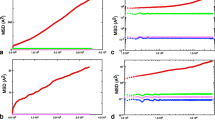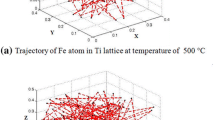Abstract
Quantum-mechanical calculations of the energies of the formation of Frenkel pairs and barriers for hydrogen migration via different mechanisms in the titanium hydride δ-TiH x and in the α phase of titanium have been carried out. Using the potential of interaction developed for the molecular-dynamic simulation, diffusion coefficients of hydrogen in fcc and hcp lattices of TiH x were calculated depending on the temperature. The opportunity to approximate the coefficients of hydrogen self-diffusion has been analyzed in terms of the model of non-interacting point defects. For δ-TiH x , the range of concentrations and temperatures was separated where the self-diffusion of hydrogen becomes liquid-like (ceases be dependent on the hydrogen concentration), upon the transition into which there takes place a sharp increase in the isochoric heat capacity. The effect of defects in the Ti sublattice on the coefficient of self-diffusion of H has been investigated.
Similar content being viewed by others
References
W. Mueller, D. Blackledge, and G. G. Libowitz, Metal Hydrides (Academic, New York, 1968; Atomizdat, Moscow, 1973).
B. A. Kolachev, V. V. Sadkov, V. D. Talalaev, and A. V. Fishgoit, Vacuum Annealing of Titanium Constructions (Mashinostroenie, Moscow, 1991) [in Russian].
Y. Fukai, The Metal–Hydrogen System: Basic Bulk Properties (Springer, New York, 2009).
G. E. Norman and V. V. Stegailov, “Stochastic theory of the classical molecular dynamics method,” Mathem. Models Compt. Simul. 5, 305–333 (2013).
S. J. Plimpton, “Fast parallel algorithms for shortrange molecular dynamics,” J. Compt. Phys. 117, 1–19 (1995).
The potential in the format for LAMMPS is available by an e-mail request from the address alexey.kuksin@gmail.ru
Y. Mishin, M. J. Mehl, and D. A. Papaconstantopoulos, “Phase stability in the Fe–Ni system: Investigation by first-principle calculations and atomistic simulations,” Acta Mater. 53, 4029–4041 (2005).
F. Apostol and Y. Mishin, “Angular-dependent interatomic potential for the aluminum-hydrogen system,” Phys. Rev. B: Condens. Matter Mater. Phys. 82, 144115 (2010).
D. E. Smirnova, A. Yu. Kuksin, S. V. Starikov, and V. V. Stegailov, “Atomistic modeling of the self-diffusion in ?-U and ?-U–Mo,” Phys. Met. Metallogr. 116, 445–455 (2015).
F. Ercolessi and J. B. Adams, “Interatomic potentials from first-principles calculations: The force-matching method,” Europhys. Lett. 26, 583–590 (1994).
P. Brommer and F. Gähler, “Potfit: Effective potentials from ab initio data,” Model. Simul. Mater. Sci. Eng. 15, 295–304 (2007).
P. Brommer and F. Gähler, “Effective potentials for quasicrystals from ab-initio data,” Philos. Mag. 86, 753–758 (2006).
G. Kresse and J. Hafner, “Ab initio molecular dynamics for liqud metals,” Phys. Rev. B: Condens. Matter 47, 558–561 (1993).
G. Kresse and J. Furthmuller, “Efficient iterative schemes for ab initio total-energy calculations using a plane-wave basis set,” Phys. Rev. B: Condens. Matter 54, 11169–11186 (1996).
P. E. Blochl, “Projector augmented-wave method,” Phys. Rev. B: Condens. Matter 50, 17953–17979 (1994).
G. Kresse and D. Joubert, “From ultrasoft pseudopotentials to the projector augmented-wave method,” Phys. Rev. B: Condens. Matter 59, 1758–1775 (1999).
Chemist Handbook (NTI Khim. Lit., Moscow, 1962) [in Russian].
D. Connetable, J. Huez, E. Andrieu, and C. Mijoule, “First-principles study of diffusion and interactions of vacancies and hydrogen in HCP-titanium,” J. Phys.: Condens. Matter 23, 405401 (2011).
A. Yu. Kuksin, A. S. Rokhmanenkov, and V. V. Stegailov, “Atomic positions and diffusion paths of H and He in the a-Ti lattice,” Phys. Solid State 55, 367–372 (2013).
P. E. Vullum, M. Pitt, J. Walmsley, B. Hauback, and R. Holmestad, “Observations of nanoscopic, face centered cubic Ti and TiHx,” Appl. Phys. A: Mater. Sci. Process. 94, 787–793 (2009).
G. Henkelman, B. P. Uberuaga, and H. Jonsson, “A climbing image nudged elastic band method for finding saddle points and minimum energy paths,” J. Chem. Phys. 113, 9901–9904 (2000).
V. M. Katlinskii, “Some regularities and parameters of hydrogen diffusion into ten transition metals,” Izv. AN SSSR. Neorg. Mater. 14, 1667–1673 (1978).
M. Krussanova, M. Terzieva, P. Peshev, K. Petrov, M. Pezat, J. P. Manaud, and B. Dariet, “Calcium-substituted lanthanum–magnesium alloys for hydrogen storage,” Int. J. Hydrogen Energy 10, 591–594 (1985).
O. P. Nazimov and L. N. Zhuravlev, “Hydrogen diffusion in titanium,” Izv. Vuzov. Tsvetn. Metall., No. 1, 160–162 (1976).
W. Kunz, H. Münzel, U. Helfrich, and H. Horneff, “Diffusionskoeffizienten für tritium in den α-phasen von titan und hafnium,” Z. Metallkd. 74, 289–296 (1983).
E. B. Boiko, A. M. Solodinin, and A. Andrievskii, “Study of hydrogen diffusion in hydrides of IV Group metals,” in Proc. Int. Symp. on the Thermodynamics of Nuclear Materials (Int. Atomic Energy Agency, Julich, 1980), p. 303.
M. M. Antonova, Properties of Metal Hydrides (Naukova Dumka, Kiev, 1975) [in Russian].
U. Kaess, G. Majer, and M. Stoll, “Hydrogen and deuterium diffusion in titanium dihydrides/dideuterides,” J. Alloys Compd. 259, 74–82 (1997).
A. V. Yanilkin, “Quantum molecular dynamics simulation of hydrogen diffusion in zirconium hydride,” Phys. Solid State 56, 1879–1885 (2014).
Author information
Authors and Affiliations
Corresponding author
Additional information
Original Russian Text © A.S. Rokhmanenkov, A.Yu. Kuksin, A.V. Yanilkin, 2017, published in Fizika Metallov i Metallovedenie, 2017, Vol. 118, No. 1, pp. 31–41.
Rights and permissions
About this article
Cite this article
Rokhmanenkov, A.S., Kuksin, A.Y. & Yanilkin, A.V. Simulation of hydrogen diffusion in TiH x structures. Phys. Metals Metallogr. 118, 28–38 (2017). https://doi.org/10.1134/S0031918X16100094
Received:
Accepted:
Published:
Issue Date:
DOI: https://doi.org/10.1134/S0031918X16100094




